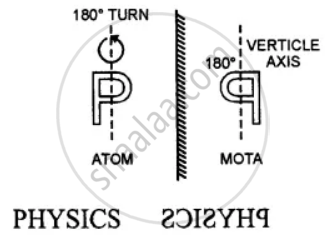Advertisements
Advertisements
प्रश्न
(a) What do you understand by the term lateral inversion?
(b) A printed card has letters PHYSICS. By drawing the diagram show the appearance of the letters. (No ray diagram is required).
उत्तर
(a) Lateral Inversion. The phenomenon due to which the image of an object turns through an angle of 180° through verticle axis rather the horizontal axis, such that right side of image appears as left or vice-versa is called Lateral Inversion. During lateral inversion, the left side of object appears as the right side of the image and vice-versa. In a way, the image turns through the angle of 180° about a vertical axis.

APPEARS IN
संबंधित प्रश्न
Select the correct alternative
The angle between the incident ray and the ray reflected from the plane mirror is 70°. The angle of incidence will be :
An insect is sitting in front of a plane mirror at a distance 1 m from it.
(b) What is the distance between the insect and its image?
An object is kept at 60 cm in front of a plane mirror. If the mirror is now moved 25 cm away from the object, how does the image shift from its previous position?
Two plane mirrors are arranged parallel and facing each other at some separation. How many images are formed for a point object kept in between them? Show the formation of images with the help of a ray diagram
State two uses of a plane mirror.
An object is placed (i) asymmetrically (ii) symmetrically, between two plane mirrors inclined at an angle of 50°. Find the number of images formed.
Explain the following term:
Normal Draw
diagram/diagrams to show them.
Prove geometrically that when plane mirror turns through a certain angle, the reflected ray turns through twice the angle.
An insect is sitting in front of a plane mirror at a distance of one meter from it.
- Where is the image of insect formed?
- What is the distance between insect and its image?
- State any two characteristics of image formed in a plane mirror.
Parallel rays are incident:
- on regular surface and
- on irregular surface. In what respect do reflected rays in (1) differ from those of (2)?
